Research on Human Factors
VerifiedAdded on 2020/03/16
|12
|2495
|243
AI Summary
Contribute Materials
Your contribution can guide someone’s learning journey. Share your
documents today.
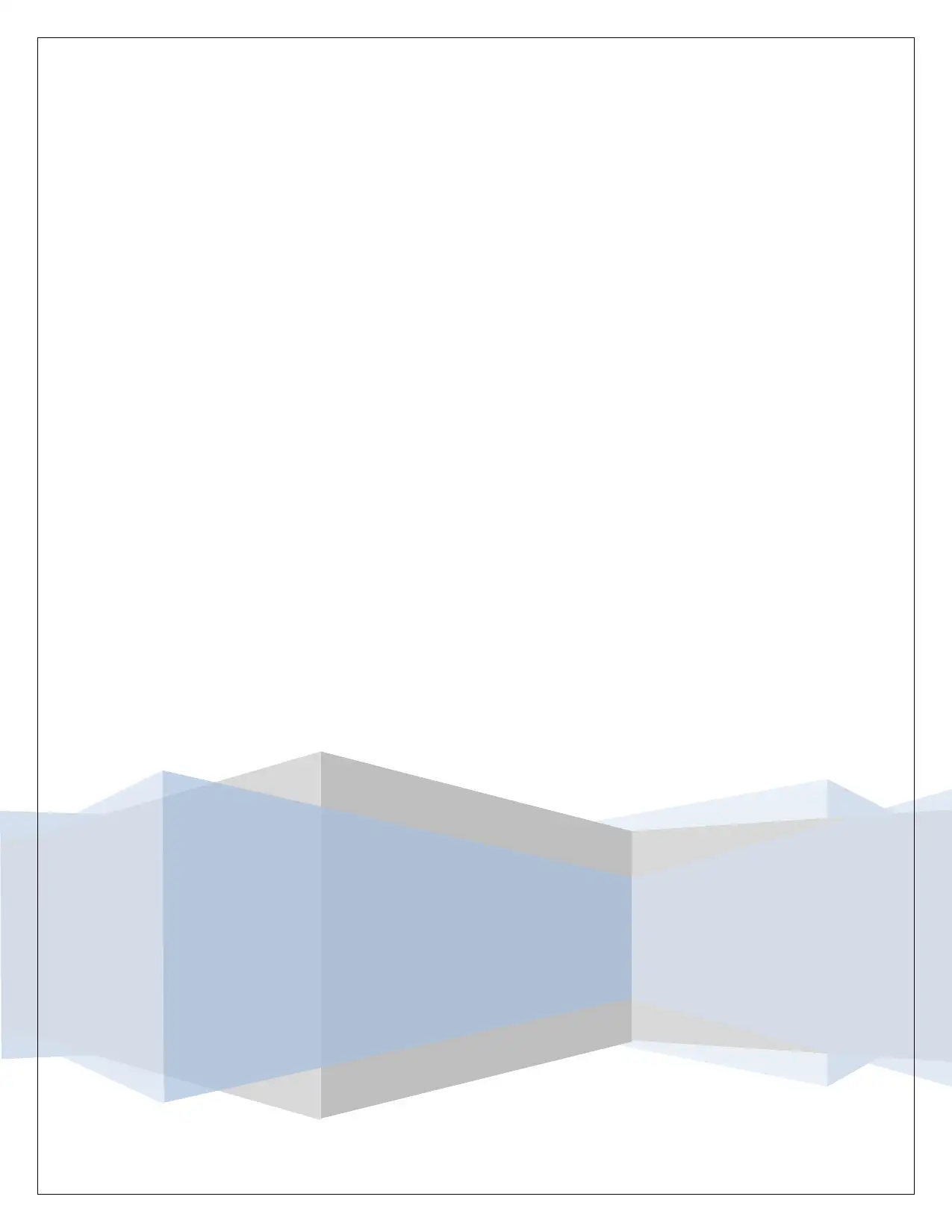
Secure Best Marks with AI Grader
Need help grading? Try our AI Grader for instant feedback on your assignments.

Running Head: Report
Contents
Introduction.................................................................................................................................................2
Human factors contributing to job performance..........................................................................................2
Importance of workplace quality and safety in healthcare sector.................................................................5
Critical analysis...........................................................................................................................................7
Overview of human error theory.................................................................................................................8
Conclusion...................................................................................................................................................9
References.................................................................................................................................................10
1
Contents
Introduction.................................................................................................................................................2
Human factors contributing to job performance..........................................................................................2
Importance of workplace quality and safety in healthcare sector.................................................................5
Critical analysis...........................................................................................................................................7
Overview of human error theory.................................................................................................................8
Conclusion...................................................................................................................................................9
References.................................................................................................................................................10
1
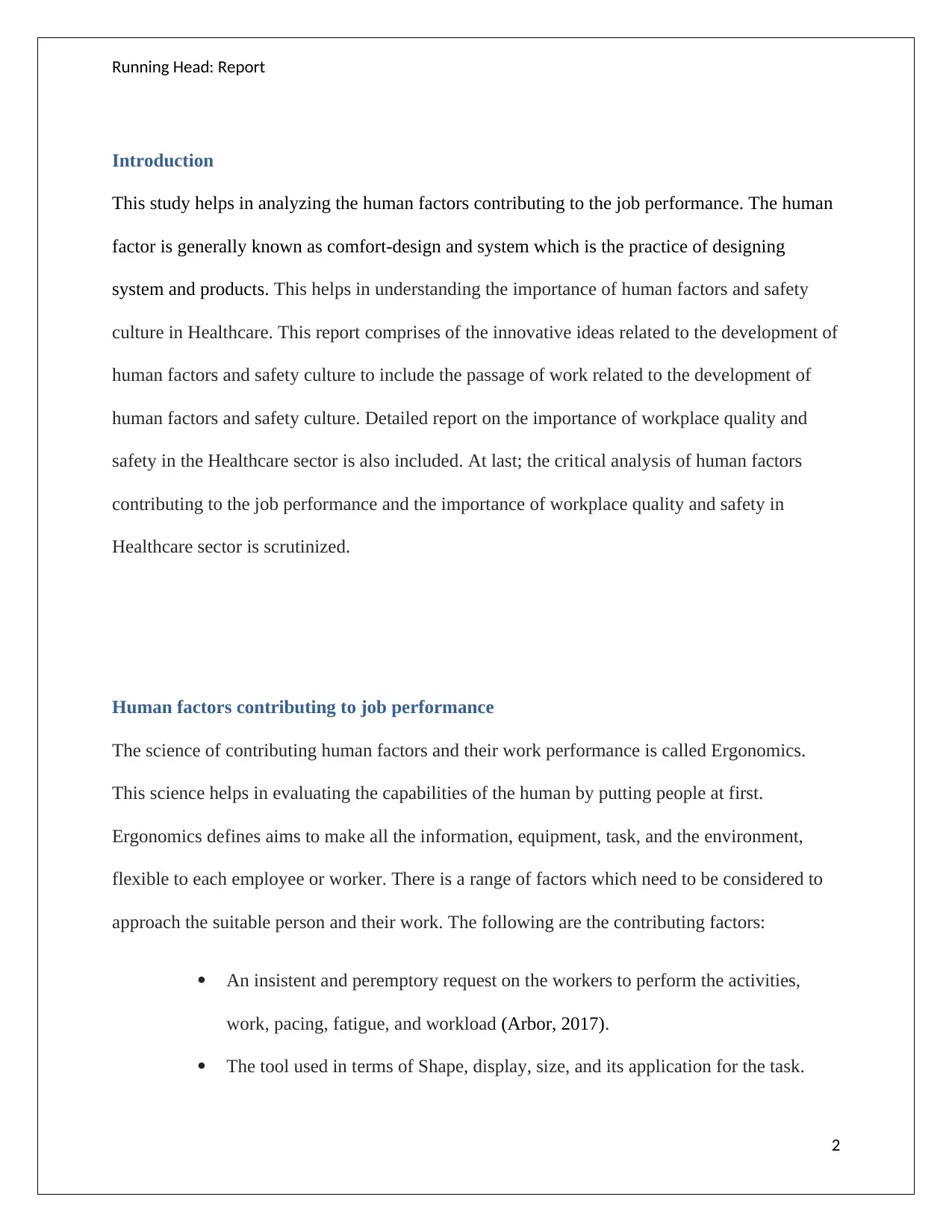
Running Head: Report
Introduction
This study helps in analyzing the human factors contributing to the job performance. The human
factor is generally known as comfort-design and system which is the practice of designing
system and products. This helps in understanding the importance of human factors and safety
culture in Healthcare. This report comprises of the innovative ideas related to the development of
human factors and safety culture to include the passage of work related to the development of
human factors and safety culture. Detailed report on the importance of workplace quality and
safety in the Healthcare sector is also included. At last; the critical analysis of human factors
contributing to the job performance and the importance of workplace quality and safety in
Healthcare sector is scrutinized.
Human factors contributing to job performance
The science of contributing human factors and their work performance is called Ergonomics.
This science helps in evaluating the capabilities of the human by putting people at first.
Ergonomics defines aims to make all the information, equipment, task, and the environment,
flexible to each employee or worker. There is a range of factors which need to be considered to
approach the suitable person and their work. The following are the contributing factors:
An insistent and peremptory request on the workers to perform the activities,
work, pacing, fatigue, and workload (Arbor, 2017).
The tool used in terms of Shape, display, size, and its application for the task.
2
Introduction
This study helps in analyzing the human factors contributing to the job performance. The human
factor is generally known as comfort-design and system which is the practice of designing
system and products. This helps in understanding the importance of human factors and safety
culture in Healthcare. This report comprises of the innovative ideas related to the development of
human factors and safety culture to include the passage of work related to the development of
human factors and safety culture. Detailed report on the importance of workplace quality and
safety in the Healthcare sector is also included. At last; the critical analysis of human factors
contributing to the job performance and the importance of workplace quality and safety in
Healthcare sector is scrutinized.
Human factors contributing to job performance
The science of contributing human factors and their work performance is called Ergonomics.
This science helps in evaluating the capabilities of the human by putting people at first.
Ergonomics defines aims to make all the information, equipment, task, and the environment,
flexible to each employee or worker. There is a range of factors which need to be considered to
approach the suitable person and their work. The following are the contributing factors:
An insistent and peremptory request on the workers to perform the activities,
work, pacing, fatigue, and workload (Arbor, 2017).
The tool used in terms of Shape, display, size, and its application for the task.
2
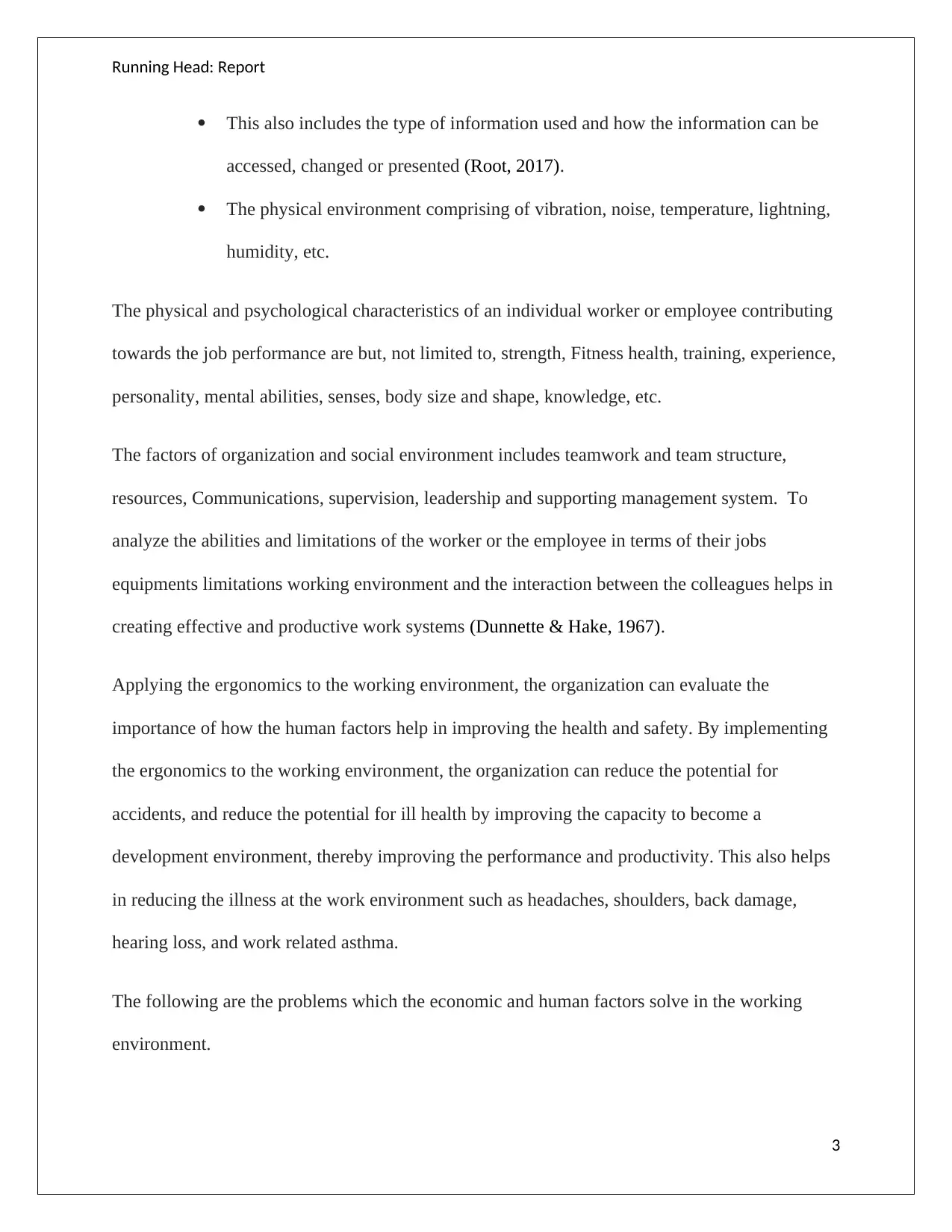
Running Head: Report
This also includes the type of information used and how the information can be
accessed, changed or presented (Root, 2017).
The physical environment comprising of vibration, noise, temperature, lightning,
humidity, etc.
The physical and psychological characteristics of an individual worker or employee contributing
towards the job performance are but, not limited to, strength, Fitness health, training, experience,
personality, mental abilities, senses, body size and shape, knowledge, etc.
The factors of organization and social environment includes teamwork and team structure,
resources, Communications, supervision, leadership and supporting management system. To
analyze the abilities and limitations of the worker or the employee in terms of their jobs
equipments limitations working environment and the interaction between the colleagues helps in
creating effective and productive work systems (Dunnette & Hake, 1967).
Applying the ergonomics to the working environment, the organization can evaluate the
importance of how the human factors help in improving the health and safety. By implementing
the ergonomics to the working environment, the organization can reduce the potential for
accidents, and reduce the potential for ill health by improving the capacity to become a
development environment, thereby improving the performance and productivity. This also helps
in reducing the illness at the work environment such as headaches, shoulders, back damage,
hearing loss, and work related asthma.
The following are the problems which the economic and human factors solve in the working
environment.
3
This also includes the type of information used and how the information can be
accessed, changed or presented (Root, 2017).
The physical environment comprising of vibration, noise, temperature, lightning,
humidity, etc.
The physical and psychological characteristics of an individual worker or employee contributing
towards the job performance are but, not limited to, strength, Fitness health, training, experience,
personality, mental abilities, senses, body size and shape, knowledge, etc.
The factors of organization and social environment includes teamwork and team structure,
resources, Communications, supervision, leadership and supporting management system. To
analyze the abilities and limitations of the worker or the employee in terms of their jobs
equipments limitations working environment and the interaction between the colleagues helps in
creating effective and productive work systems (Dunnette & Hake, 1967).
Applying the ergonomics to the working environment, the organization can evaluate the
importance of how the human factors help in improving the health and safety. By implementing
the ergonomics to the working environment, the organization can reduce the potential for
accidents, and reduce the potential for ill health by improving the capacity to become a
development environment, thereby improving the performance and productivity. This also helps
in reducing the illness at the work environment such as headaches, shoulders, back damage,
hearing loss, and work related asthma.
The following are the problems which the economic and human factors solve in the working
environment.
3
Paraphrase This Document
Need a fresh take? Get an instant paraphrase of this document with our AI Paraphraser
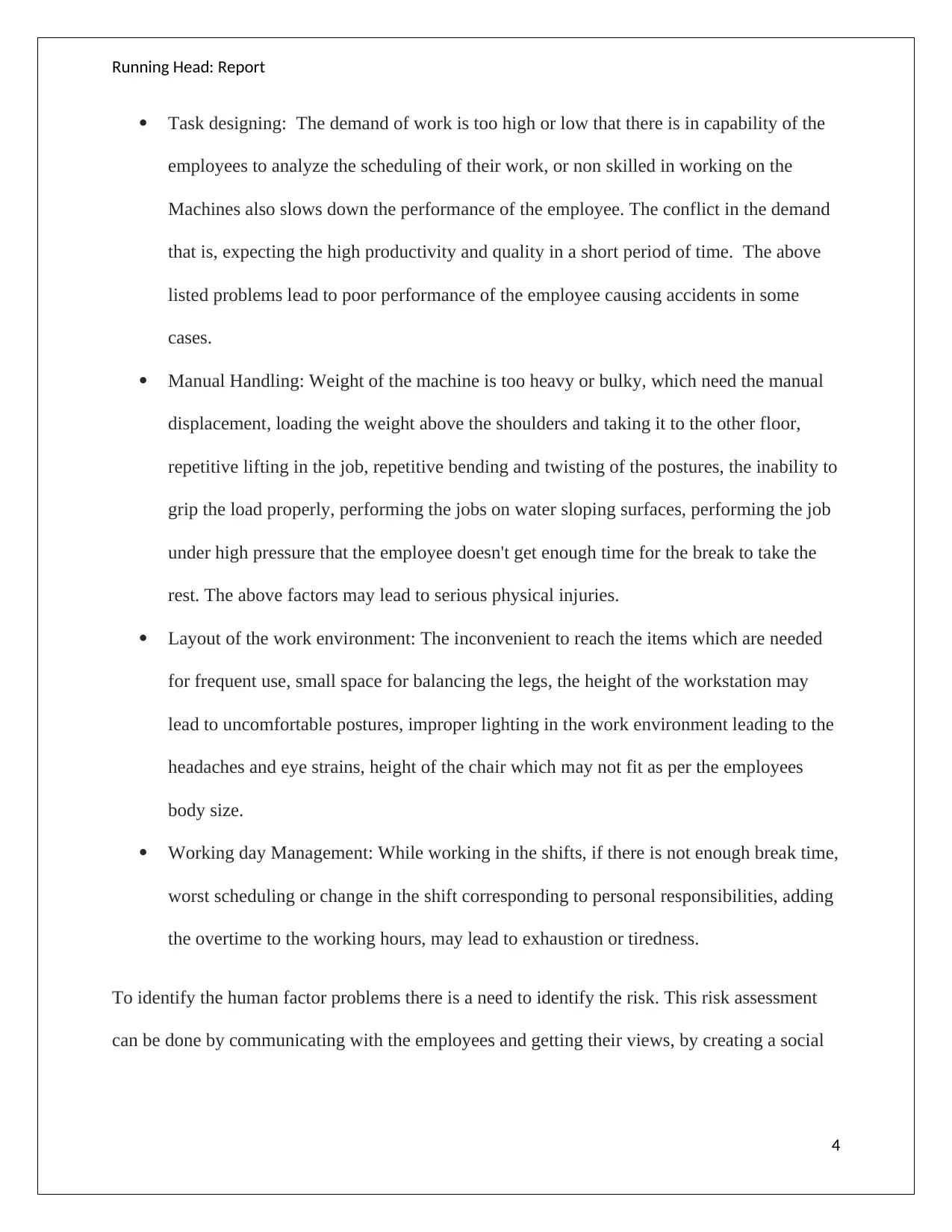
Running Head: Report
Task designing: The demand of work is too high or low that there is in capability of the
employees to analyze the scheduling of their work, or non skilled in working on the
Machines also slows down the performance of the employee. The conflict in the demand
that is, expecting the high productivity and quality in a short period of time. The above
listed problems lead to poor performance of the employee causing accidents in some
cases.
Manual Handling: Weight of the machine is too heavy or bulky, which need the manual
displacement, loading the weight above the shoulders and taking it to the other floor,
repetitive lifting in the job, repetitive bending and twisting of the postures, the inability to
grip the load properly, performing the jobs on water sloping surfaces, performing the job
under high pressure that the employee doesn't get enough time for the break to take the
rest. The above factors may lead to serious physical injuries.
Layout of the work environment: The inconvenient to reach the items which are needed
for frequent use, small space for balancing the legs, the height of the workstation may
lead to uncomfortable postures, improper lighting in the work environment leading to the
headaches and eye strains, height of the chair which may not fit as per the employees
body size.
Working day Management: While working in the shifts, if there is not enough break time,
worst scheduling or change in the shift corresponding to personal responsibilities, adding
the overtime to the working hours, may lead to exhaustion or tiredness.
To identify the human factor problems there is a need to identify the risk. This risk assessment
can be done by communicating with the employees and getting their views, by creating a social
4
Task designing: The demand of work is too high or low that there is in capability of the
employees to analyze the scheduling of their work, or non skilled in working on the
Machines also slows down the performance of the employee. The conflict in the demand
that is, expecting the high productivity and quality in a short period of time. The above
listed problems lead to poor performance of the employee causing accidents in some
cases.
Manual Handling: Weight of the machine is too heavy or bulky, which need the manual
displacement, loading the weight above the shoulders and taking it to the other floor,
repetitive lifting in the job, repetitive bending and twisting of the postures, the inability to
grip the load properly, performing the jobs on water sloping surfaces, performing the job
under high pressure that the employee doesn't get enough time for the break to take the
rest. The above factors may lead to serious physical injuries.
Layout of the work environment: The inconvenient to reach the items which are needed
for frequent use, small space for balancing the legs, the height of the workstation may
lead to uncomfortable postures, improper lighting in the work environment leading to the
headaches and eye strains, height of the chair which may not fit as per the employees
body size.
Working day Management: While working in the shifts, if there is not enough break time,
worst scheduling or change in the shift corresponding to personal responsibilities, adding
the overtime to the working hours, may lead to exhaustion or tiredness.
To identify the human factor problems there is a need to identify the risk. This risk assessment
can be done by communicating with the employees and getting their views, by creating a social
4
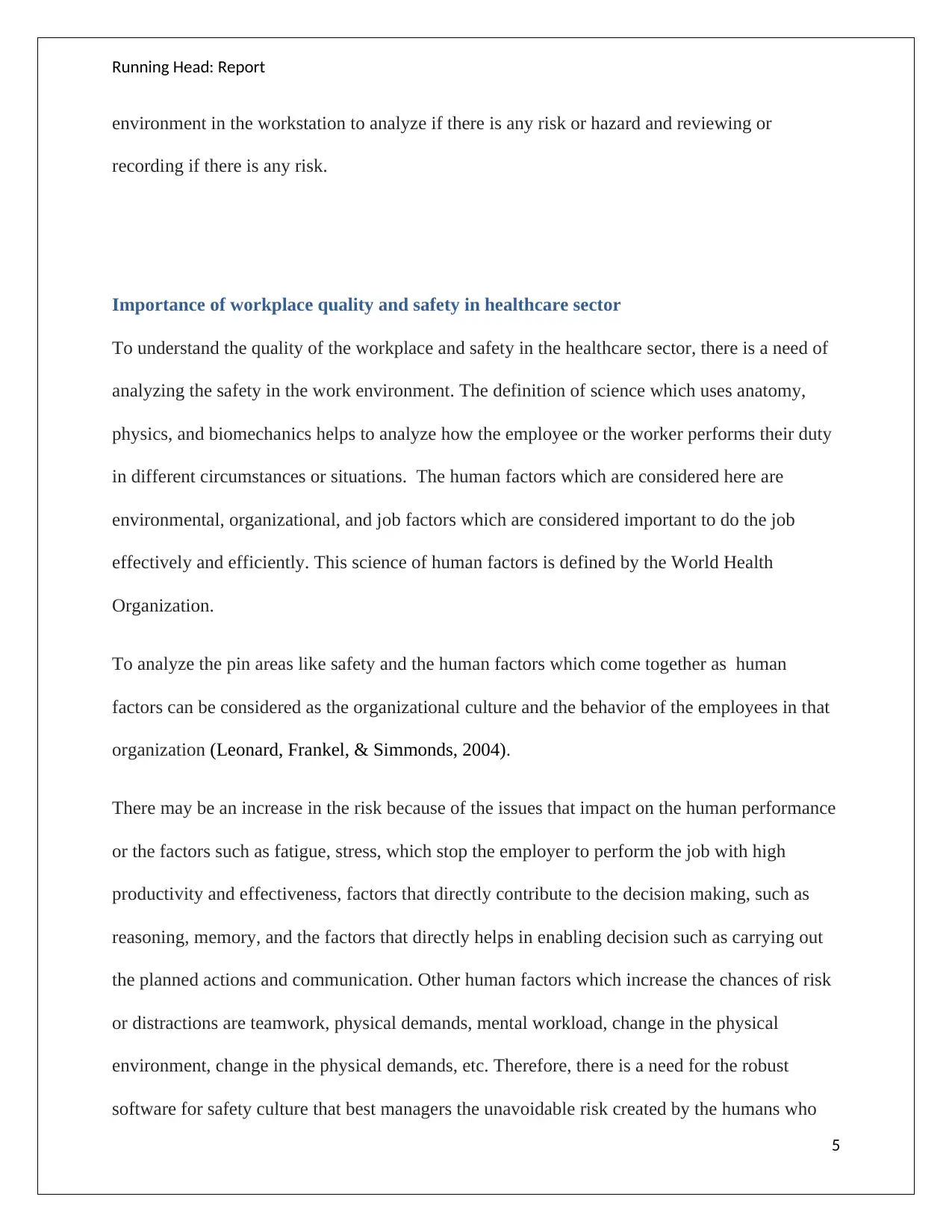
Running Head: Report
environment in the workstation to analyze if there is any risk or hazard and reviewing or
recording if there is any risk.
Importance of workplace quality and safety in healthcare sector
To understand the quality of the workplace and safety in the healthcare sector, there is a need of
analyzing the safety in the work environment. The definition of science which uses anatomy,
physics, and biomechanics helps to analyze how the employee or the worker performs their duty
in different circumstances or situations. The human factors which are considered here are
environmental, organizational, and job factors which are considered important to do the job
effectively and efficiently. This science of human factors is defined by the World Health
Organization.
To analyze the pin areas like safety and the human factors which come together as human
factors can be considered as the organizational culture and the behavior of the employees in that
organization (Leonard, Frankel, & Simmonds, 2004).
There may be an increase in the risk because of the issues that impact on the human performance
or the factors such as fatigue, stress, which stop the employer to perform the job with high
productivity and effectiveness, factors that directly contribute to the decision making, such as
reasoning, memory, and the factors that directly helps in enabling decision such as carrying out
the planned actions and communication. Other human factors which increase the chances of risk
or distractions are teamwork, physical demands, mental workload, change in the physical
environment, change in the physical demands, etc. Therefore, there is a need for the robust
software for safety culture that best managers the unavoidable risk created by the humans who
5
environment in the workstation to analyze if there is any risk or hazard and reviewing or
recording if there is any risk.
Importance of workplace quality and safety in healthcare sector
To understand the quality of the workplace and safety in the healthcare sector, there is a need of
analyzing the safety in the work environment. The definition of science which uses anatomy,
physics, and biomechanics helps to analyze how the employee or the worker performs their duty
in different circumstances or situations. The human factors which are considered here are
environmental, organizational, and job factors which are considered important to do the job
effectively and efficiently. This science of human factors is defined by the World Health
Organization.
To analyze the pin areas like safety and the human factors which come together as human
factors can be considered as the organizational culture and the behavior of the employees in that
organization (Leonard, Frankel, & Simmonds, 2004).
There may be an increase in the risk because of the issues that impact on the human performance
or the factors such as fatigue, stress, which stop the employer to perform the job with high
productivity and effectiveness, factors that directly contribute to the decision making, such as
reasoning, memory, and the factors that directly helps in enabling decision such as carrying out
the planned actions and communication. Other human factors which increase the chances of risk
or distractions are teamwork, physical demands, mental workload, change in the physical
environment, change in the physical demands, etc. Therefore, there is a need for the robust
software for safety culture that best managers the unavoidable risk created by the humans who
5
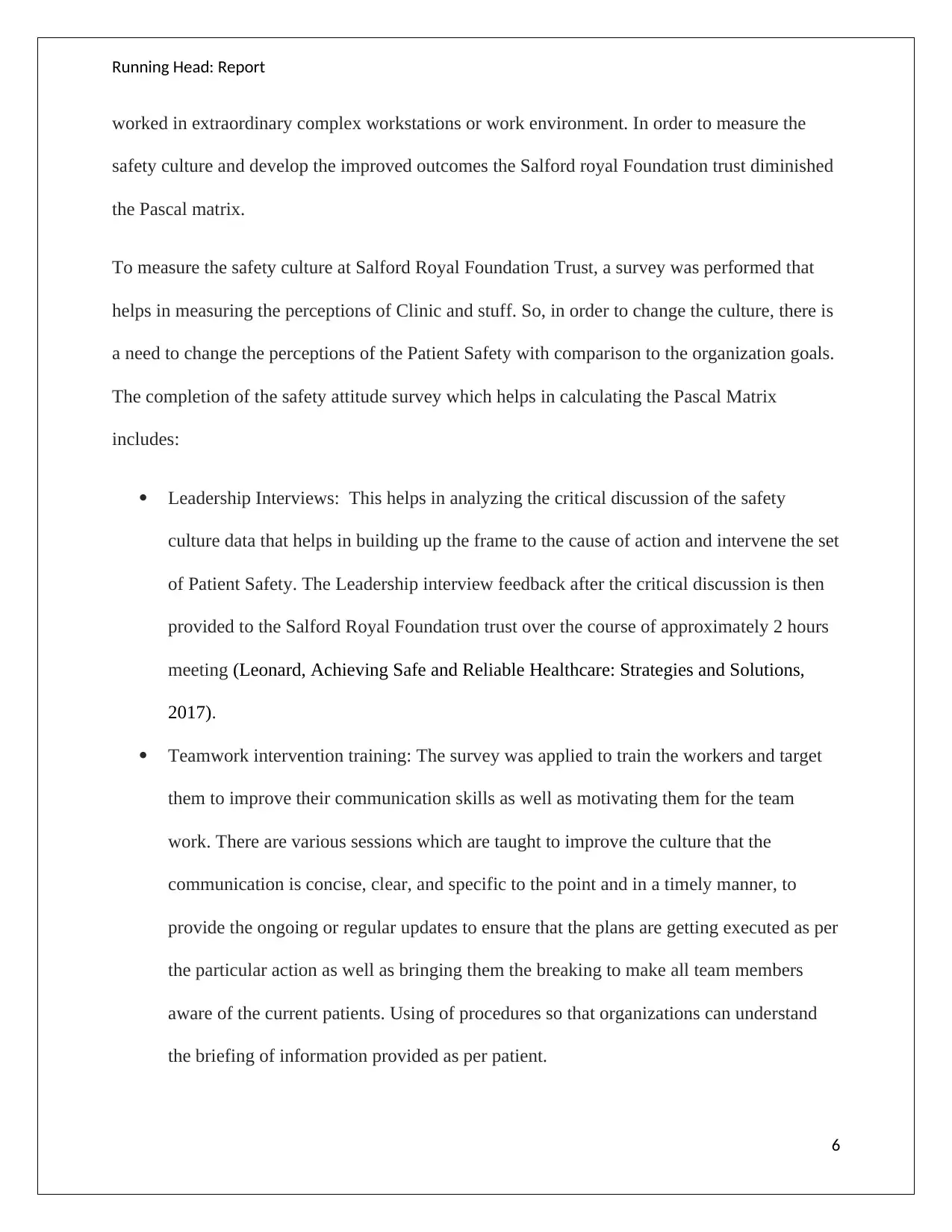
Running Head: Report
worked in extraordinary complex workstations or work environment. In order to measure the
safety culture and develop the improved outcomes the Salford royal Foundation trust diminished
the Pascal matrix.
To measure the safety culture at Salford Royal Foundation Trust, a survey was performed that
helps in measuring the perceptions of Clinic and stuff. So, in order to change the culture, there is
a need to change the perceptions of the Patient Safety with comparison to the organization goals.
The completion of the safety attitude survey which helps in calculating the Pascal Matrix
includes:
Leadership Interviews: This helps in analyzing the critical discussion of the safety
culture data that helps in building up the frame to the cause of action and intervene the set
of Patient Safety. The Leadership interview feedback after the critical discussion is then
provided to the Salford Royal Foundation trust over the course of approximately 2 hours
meeting (Leonard, Achieving Safe and Reliable Healthcare: Strategies and Solutions,
2017).
Teamwork intervention training: The survey was applied to train the workers and target
them to improve their communication skills as well as motivating them for the team
work. There are various sessions which are taught to improve the culture that the
communication is concise, clear, and specific to the point and in a timely manner, to
provide the ongoing or regular updates to ensure that the plans are getting executed as per
the particular action as well as bringing them the breaking to make all team members
aware of the current patients. Using of procedures so that organizations can understand
the briefing of information provided as per patient.
6
worked in extraordinary complex workstations or work environment. In order to measure the
safety culture and develop the improved outcomes the Salford royal Foundation trust diminished
the Pascal matrix.
To measure the safety culture at Salford Royal Foundation Trust, a survey was performed that
helps in measuring the perceptions of Clinic and stuff. So, in order to change the culture, there is
a need to change the perceptions of the Patient Safety with comparison to the organization goals.
The completion of the safety attitude survey which helps in calculating the Pascal Matrix
includes:
Leadership Interviews: This helps in analyzing the critical discussion of the safety
culture data that helps in building up the frame to the cause of action and intervene the set
of Patient Safety. The Leadership interview feedback after the critical discussion is then
provided to the Salford Royal Foundation trust over the course of approximately 2 hours
meeting (Leonard, Achieving Safe and Reliable Healthcare: Strategies and Solutions,
2017).
Teamwork intervention training: The survey was applied to train the workers and target
them to improve their communication skills as well as motivating them for the team
work. There are various sessions which are taught to improve the culture that the
communication is concise, clear, and specific to the point and in a timely manner, to
provide the ongoing or regular updates to ensure that the plans are getting executed as per
the particular action as well as bringing them the breaking to make all team members
aware of the current patients. Using of procedures so that organizations can understand
the briefing of information provided as per patient.
6
Secure Best Marks with AI Grader
Need help grading? Try our AI Grader for instant feedback on your assignments.
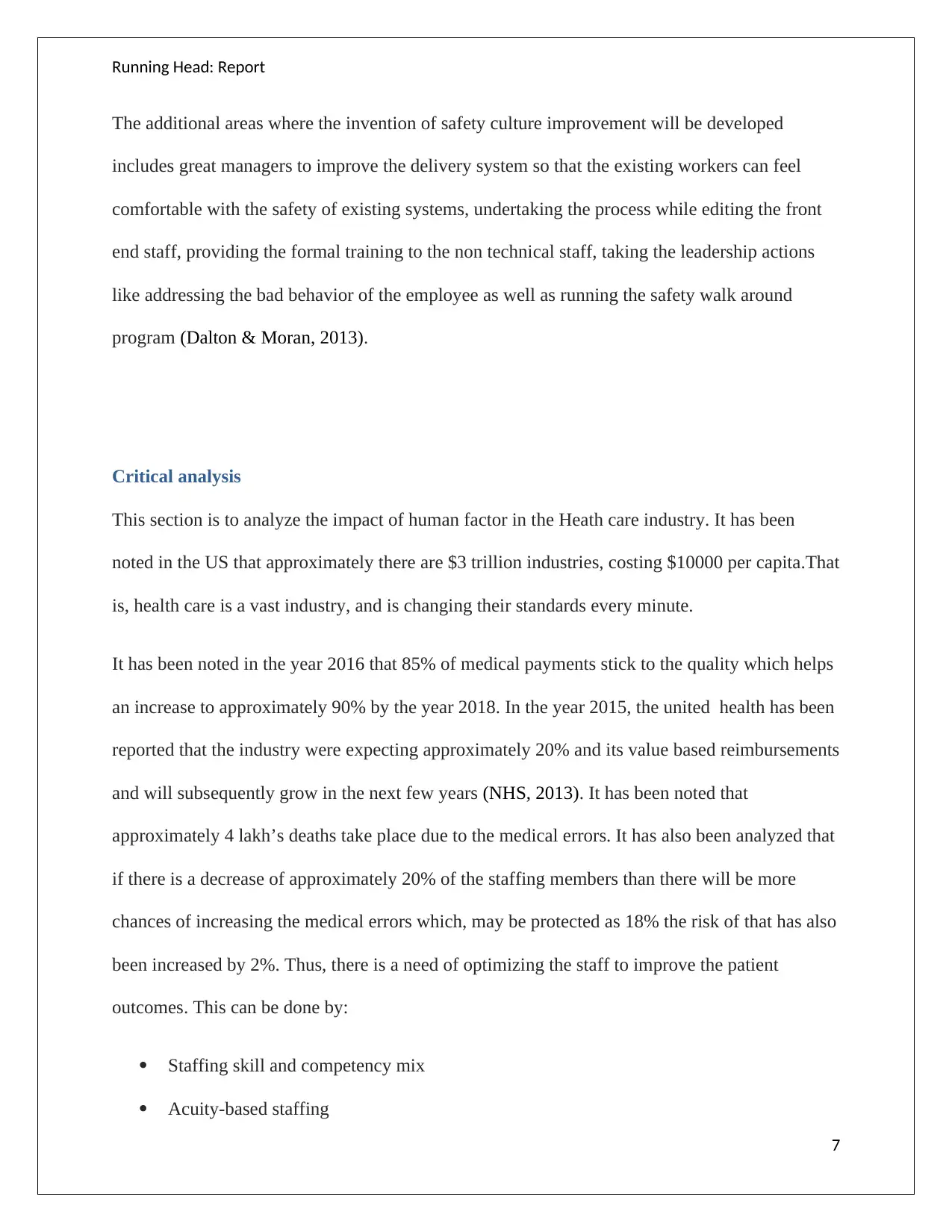
Running Head: Report
The additional areas where the invention of safety culture improvement will be developed
includes great managers to improve the delivery system so that the existing workers can feel
comfortable with the safety of existing systems, undertaking the process while editing the front
end staff, providing the formal training to the non technical staff, taking the leadership actions
like addressing the bad behavior of the employee as well as running the safety walk around
program (Dalton & Moran, 2013).
Critical analysis
This section is to analyze the impact of human factor in the Heath care industry. It has been
noted in the US that approximately there are $3 trillion industries, costing $10000 per capita.That
is, health care is a vast industry, and is changing their standards every minute.
It has been noted in the year 2016 that 85% of medical payments stick to the quality which helps
an increase to approximately 90% by the year 2018. In the year 2015, the united health has been
reported that the industry were expecting approximately 20% and its value based reimbursements
and will subsequently grow in the next few years (NHS, 2013). It has been noted that
approximately 4 lakh’s deaths take place due to the medical errors. It has also been analyzed that
if there is a decrease of approximately 20% of the staffing members than there will be more
chances of increasing the medical errors which, may be protected as 18% the risk of that has also
been increased by 2%. Thus, there is a need of optimizing the staff to improve the patient
outcomes. This can be done by:
Staffing skill and competency mix
Acuity-based staffing
7
The additional areas where the invention of safety culture improvement will be developed
includes great managers to improve the delivery system so that the existing workers can feel
comfortable with the safety of existing systems, undertaking the process while editing the front
end staff, providing the formal training to the non technical staff, taking the leadership actions
like addressing the bad behavior of the employee as well as running the safety walk around
program (Dalton & Moran, 2013).
Critical analysis
This section is to analyze the impact of human factor in the Heath care industry. It has been
noted in the US that approximately there are $3 trillion industries, costing $10000 per capita.That
is, health care is a vast industry, and is changing their standards every minute.
It has been noted in the year 2016 that 85% of medical payments stick to the quality which helps
an increase to approximately 90% by the year 2018. In the year 2015, the united health has been
reported that the industry were expecting approximately 20% and its value based reimbursements
and will subsequently grow in the next few years (NHS, 2013). It has been noted that
approximately 4 lakh’s deaths take place due to the medical errors. It has also been analyzed that
if there is a decrease of approximately 20% of the staffing members than there will be more
chances of increasing the medical errors which, may be protected as 18% the risk of that has also
been increased by 2%. Thus, there is a need of optimizing the staff to improve the patient
outcomes. This can be done by:
Staffing skill and competency mix
Acuity-based staffing
7
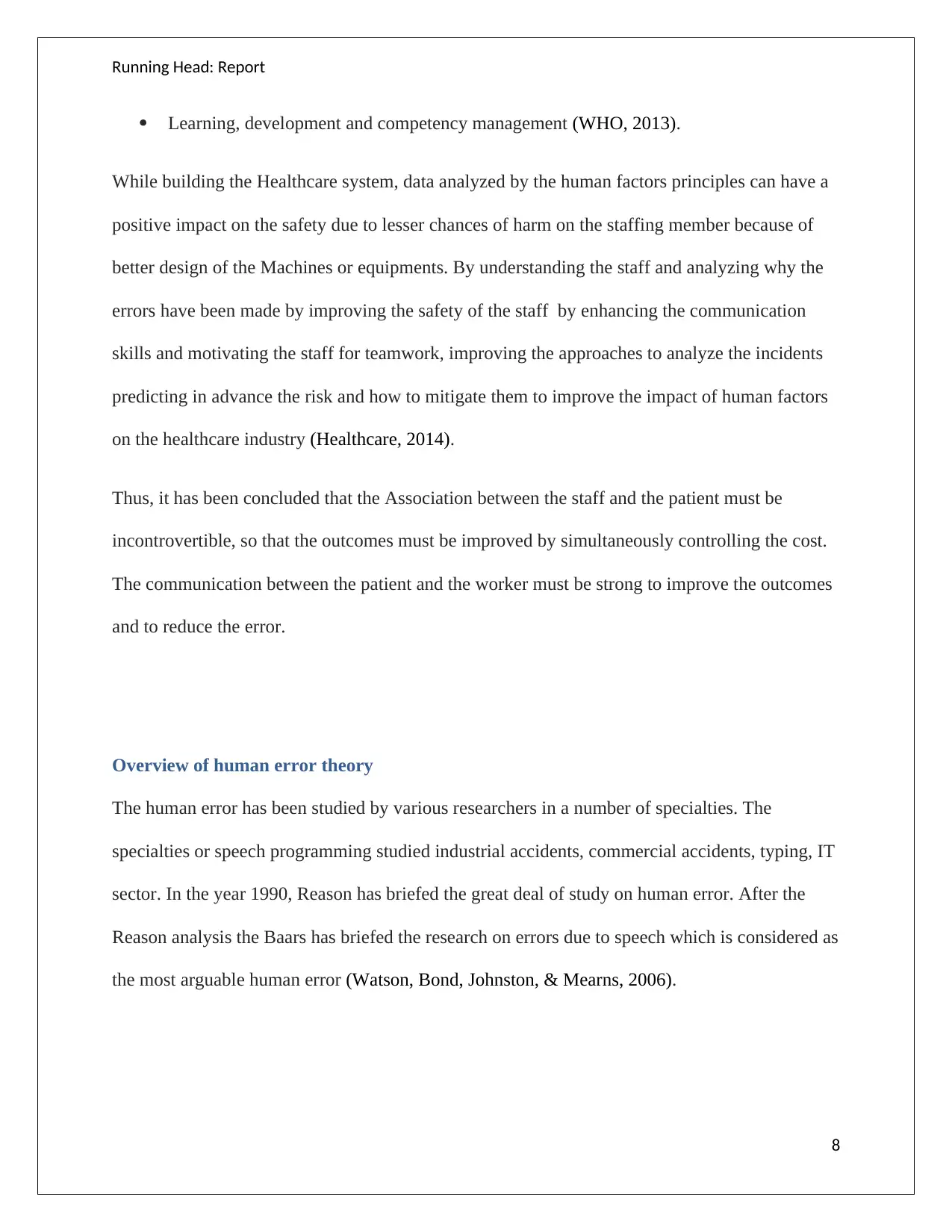
Running Head: Report
Learning, development and competency management (WHO, 2013).
While building the Healthcare system, data analyzed by the human factors principles can have a
positive impact on the safety due to lesser chances of harm on the staffing member because of
better design of the Machines or equipments. By understanding the staff and analyzing why the
errors have been made by improving the safety of the staff by enhancing the communication
skills and motivating the staff for teamwork, improving the approaches to analyze the incidents
predicting in advance the risk and how to mitigate them to improve the impact of human factors
on the healthcare industry (Healthcare, 2014).
Thus, it has been concluded that the Association between the staff and the patient must be
incontrovertible, so that the outcomes must be improved by simultaneously controlling the cost.
The communication between the patient and the worker must be strong to improve the outcomes
and to reduce the error.
Overview of human error theory
The human error has been studied by various researchers in a number of specialties. The
specialties or speech programming studied industrial accidents, commercial accidents, typing, IT
sector. In the year 1990, Reason has briefed the great deal of study on human error. After the
Reason analysis the Baars has briefed the research on errors due to speech which is considered as
the most arguable human error (Watson, Bond, Johnston, & Mearns, 2006).
8
Learning, development and competency management (WHO, 2013).
While building the Healthcare system, data analyzed by the human factors principles can have a
positive impact on the safety due to lesser chances of harm on the staffing member because of
better design of the Machines or equipments. By understanding the staff and analyzing why the
errors have been made by improving the safety of the staff by enhancing the communication
skills and motivating the staff for teamwork, improving the approaches to analyze the incidents
predicting in advance the risk and how to mitigate them to improve the impact of human factors
on the healthcare industry (Healthcare, 2014).
Thus, it has been concluded that the Association between the staff and the patient must be
incontrovertible, so that the outcomes must be improved by simultaneously controlling the cost.
The communication between the patient and the worker must be strong to improve the outcomes
and to reduce the error.
Overview of human error theory
The human error has been studied by various researchers in a number of specialties. The
specialties or speech programming studied industrial accidents, commercial accidents, typing, IT
sector. In the year 1990, Reason has briefed the great deal of study on human error. After the
Reason analysis the Baars has briefed the research on errors due to speech which is considered as
the most arguable human error (Watson, Bond, Johnston, & Mearns, 2006).
8

Running Head: Report
Conclusion
The human factors contributing to the job performance have been analyzed in this report. The
understanding about the importance of human factors and safety culture in Healthcare is
scrutinized. This report also helped in suggesting the innovative ideas related to the development
of human factors and safety culture to include the passage of work related to the development of
human factors and safety culture. Detailed report has been prepared on the importance of
workplace quality and safety in the Healthcare sector. The critical analysis of human factors
contributing to the job performance and the importance of workplace quality and safety in
Healthcare sector has been explored in the further study related to the human factors.
9
Conclusion
The human factors contributing to the job performance have been analyzed in this report. The
understanding about the importance of human factors and safety culture in Healthcare is
scrutinized. This report also helped in suggesting the innovative ideas related to the development
of human factors and safety culture to include the passage of work related to the development of
human factors and safety culture. Detailed report has been prepared on the importance of
workplace quality and safety in the Healthcare sector. The critical analysis of human factors
contributing to the job performance and the importance of workplace quality and safety in
Healthcare sector has been explored in the further study related to the human factors.
9
Paraphrase This Document
Need a fresh take? Get an instant paraphrase of this document with our AI Paraphraser

Running Head: Report
References
Arbor, A. (2017). University of Michigan Health System Patient Safety Toolkit. Retrieved from
http://www.ihi.org/resources/Pages/Tools/UMichiganHealthSystemPatientSafetyToolkit
DisclosureChapter.aspx
Dalton, D., & Moran, S. (2013). Human factors and safety culture in healthcare. The Health
Foundation. Retrieved from
http://patientsafety.health.org.uk/sites/default/files/resources/human_factors_and_safety_
culture_in_healthcare.pdf
Dunnette, M., & Hake, M. (1967). Factors contributing to job satisfaction and job dissatisfaction
in six occupational groups. Organizational Behavior and Human Performance, 2(2), 143-
174. Retrieved from
http://www.sciencedirect.com/science/article/pii/003050736790027X
Healthcare, A. (2014). Lessening the Negative Impact of Human Factors: Linking Staffing
Variables & Patient Outcomes. Retrieved from
http://apihealthcare.com/sites/default/files/Lessening%20the%20Negative%20Impact
%20of%20Human%20Factors%20-%20JB33305US.pdf
Leonard, M. (2017). Achieving Safe and Reliable Healthcare: Strategies and Solutions.
Retrieved from https://www.alibris.com/Achieving-Safe-and-Reliable-Healthcare-
Strategies-and-Solutions-Michael-Steven-Leonard/book/8698370
Leonard, M., Frankel, A., & Simmonds, T. (2004). Achieving Safe and Reliable Healthcare:
Strategies and Solutions. Retrieved from
10
References
Arbor, A. (2017). University of Michigan Health System Patient Safety Toolkit. Retrieved from
http://www.ihi.org/resources/Pages/Tools/UMichiganHealthSystemPatientSafetyToolkit
DisclosureChapter.aspx
Dalton, D., & Moran, S. (2013). Human factors and safety culture in healthcare. The Health
Foundation. Retrieved from
http://patientsafety.health.org.uk/sites/default/files/resources/human_factors_and_safety_
culture_in_healthcare.pdf
Dunnette, M., & Hake, M. (1967). Factors contributing to job satisfaction and job dissatisfaction
in six occupational groups. Organizational Behavior and Human Performance, 2(2), 143-
174. Retrieved from
http://www.sciencedirect.com/science/article/pii/003050736790027X
Healthcare, A. (2014). Lessening the Negative Impact of Human Factors: Linking Staffing
Variables & Patient Outcomes. Retrieved from
http://apihealthcare.com/sites/default/files/Lessening%20the%20Negative%20Impact
%20of%20Human%20Factors%20-%20JB33305US.pdf
Leonard, M. (2017). Achieving Safe and Reliable Healthcare: Strategies and Solutions.
Retrieved from https://www.alibris.com/Achieving-Safe-and-Reliable-Healthcare-
Strategies-and-Solutions-Michael-Steven-Leonard/book/8698370
Leonard, M., Frankel, A., & Simmonds, T. (2004). Achieving Safe and Reliable Healthcare:
Strategies and Solutions. Retrieved from
10

Running Head: Report
http://www.ihi.org/resources/Pages/Publications/AchievingSafeandReliableHealthcareStr
ategiesandSolutions.aspx
NHS. (2013). Human Factors in Healthcare: A Concordat from the National Quality Board.
Retrieved from https://www.england.nhs.uk/wp-content/uploads/2013/11/nqb-hum-fact-
concord.pdf
Root, G. (2017). Factors Affecting Employee Performance. Retrieved from
http://smallbusiness.chron.com/factors-affecting-employee-performance-978.html
Watson, M., Bond, C., Johnston, M., & Mearns, K. (2006). Using human error theory to explore
the supply of non-prescription medicines from community pharmacies. Retrieved from
https://psnet.ahrq.gov/resources/resource/4148
WHO. (2013). What is human factors and why is it important to patient safety? Retrieved from
http://www.who.int/patientsafety/education/curriculum/who_mc_topic-2.pdf
11
http://www.ihi.org/resources/Pages/Publications/AchievingSafeandReliableHealthcareStr
ategiesandSolutions.aspx
NHS. (2013). Human Factors in Healthcare: A Concordat from the National Quality Board.
Retrieved from https://www.england.nhs.uk/wp-content/uploads/2013/11/nqb-hum-fact-
concord.pdf
Root, G. (2017). Factors Affecting Employee Performance. Retrieved from
http://smallbusiness.chron.com/factors-affecting-employee-performance-978.html
Watson, M., Bond, C., Johnston, M., & Mearns, K. (2006). Using human error theory to explore
the supply of non-prescription medicines from community pharmacies. Retrieved from
https://psnet.ahrq.gov/resources/resource/4148
WHO. (2013). What is human factors and why is it important to patient safety? Retrieved from
http://www.who.int/patientsafety/education/curriculum/who_mc_topic-2.pdf
11
1 out of 12
![[object Object]](/_next/static/media/star-bottom.7253800d.svg)





